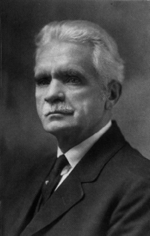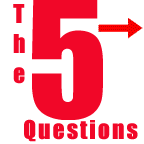The Disappointment of B. H. Roberts
| Brigham H. Roberts is revered in Mormon history as one of the Mormon
Church's greatest theologians and historians. His six-volume Comprehensive
History of the Church is still one of the most respected
works of Mormon history. Roberts was a General Authority, member of the
Mormon Church's First Council of the Seventy, a group which is second only
to the First Presidency and the Quorum of the Twelve Apostles. In 1898 he
was elected to the U. S. House of Representatives, although he was never
seated because he was a polygamist. |
 |
 |
As a young missionary in Tennessee, Roberts began to formulate his defense
of the Book of Mormon. Upon one occasion he debated a Campbellite minister
on the authority of the Book of Mormon. That debate was the beginning of
his reputation within the Mormon Church as a leading defender of the Book
of Mormon. In time he became recognized as the expert Book of Mormon
apologist. In 1909 he published his chief defense of the Book of Mormon,
entitled, New Witnesses for God.
The Doubts Begin
In 1921 an event occurred which forever changed Roberts' life. A young Mormon
from Salina, Utah, William Riter, wrote to Apostle James E. Talmage with
five questions challenging the Book of Mormon. Riter had been asked the
questions by a man from Washington, D.C. who was investigating the claims
of Mormonism. Talmage was too busy to answer the questions, so he sent the
letter on to Roberts. This was the beginning of an investigation which would
trouble Roberts until his death in 1933. The study deeply challenged his
faith in the Book of Mormon and ultimately changed his opinion of its divine
origin.
Roberts' personal struggle with his waning confidence in the Book of Mormon
is recorded in three documents he produced in the last years of his life.
None of these works was published during his lifetime, but they are now
available. A comprehensive study of these documents was published in 1985
as Studies of the Book of Mormon by the University
of Illinois. This book is edited by two Mormon scholars: Brigham D. Madsen
edited the manuscript and Sterling M. McMurrin wrote an introductory essay.
Roberts studied the questions for four months without replying to William Riter. Riter finally wrote to him, asking if he had completed his response.
On Dec. 28, 1921, Roberts wrote back saying he was studying the problems,
had not yet reached a conclusion and would soon respond. The next
day Roberts wrote an open letter to President
Heber J. Grant, to Grant's counselors, to the
Twelve Apostles and to the First Council of
Seventy, requesting an emergency meeting with all
of them to discuss the matter.
Roberts told the General Authorities:
"I found the difficulties (raised by the five questions) more serious
than I thought...it is a matter that will concern the faith of the Youth
of the Church now (and) also in the future."
President Grant responded immediately to Roberts' request for an emergency
meeting of the Church's top leadership. Within a week the brethren assembled
for an intense two-day conference at which Roberts delivered a 141 page
report entitled, "Book of Mormon Difficulties, a Study." Roberts
appealed to the collective wisdom of the brethren and said he was seeking
the inspiration of the Lord in order to answer the questions.
Disappointed
It is fair to say the General Authorities "stonewalled" Roberts
at the meeting. After two days, he came away disappointed and discouraged.
In a letter to President Grant four days after the meeting he said:
"I was greatly disappointed over the net results of the discussion...There
was so much said that was utterly irrelevant, and so little said...that
was helpful."
Roberts continued to discuss the matter through letters with President Grant
and continued for some months to meet with a committee formed out of the
larger group comprised of one of Grant's counselors, Talmage, and Apostle
John Widsoe. But, Roberts never was satisfied with the response of the brethren.
As his investigation continued, he became more and more disillusioned with
the Book of Mormon; and he always resented the response he received at the
two-day seminar. Two months before his death he told a friend, Wesley P.
Lloyd, former dean of the graduate school of BYU, that the defense the brethren
made for the Book of Mormon might "satisfy people who didn't think,
but (it was) a very inadequate answer for a thinking man." He said
Apostle Richard R. Lyman did not take the matter
seriously and the others, "merely one by one
stood up and bore testimony to the truthfulness
of the Book of Mormon. George Albert Smith-in tears-testified
that his faith in the Book of Mormon had not been shaken by the questions."
Roberts told Lloyd "in a Church which claims continuous revelation,
a crisis had arisen where revelation was necessary."
Concerning the Five Questions
Of the five questions, Roberts was most concerned about the linguistic problem.
(See accompanying sidebar "The Five Questions.") However, he also
discovered new problems. He told Lloyd he saw literary problems in
the Book of Mormon as well as geographic problems. Where, he asked, were
the Mayan cliffs and high mountain peaks in the Book of Mormon? The geography
of the Book of Mormon, Roberts said, looked suspiciously like the geography
of the New England where Joseph Smith was raised!
Joseph Smith Did Not Get The Book of Mormon From God!
Roberts eventually concluded that Joseph Smith wrote the Book of Mormon
himself-that he did not translate it from gold plates. Smith produced
it, Roberts said, by drawing upon his own natural talent and materials like
Ethan Smith's View of the Hebrews (published near Joseph's
home a few years before the translation of the Book of Mormon).
Roberts' Reaction
Roberts became convinced that View of the Hebrews was "the
ground plan" for the Book of Mormon. Roberts, the man who had started
his missionary career defending the Book of Mormon and became its staunchest
apologist, had to admit the evidence proved Joseph Smith was a plagiarist.
One must empathize with the elderly Roberts as he came to realize he had
spent a lifetime defending something which he now knew was a fraud. It is
heartbreaking. It is perhaps, this fraudulent perpetration of the Book of
Mormon that is the most heartbreaking aspect of Mormonism. Millions of Mormons
base their faith in Mormonism upon this book which is no more than the invention
of Joseph Smith. Mormon Apostle Orson Pratt correctly identified the essential
question concerning the Book of Mormon when he declared:
"If true, (the Book of Mormon) is one of the most important messages
ever sent from God to man. If false, it is one of the most cunning, wicked,
bold, deep-laid impositions ever palmed upon the world, calculated to deceive
and ruin millions who sincerely receive it as the Word of God, and will
suppose themselves built upon the rock of truth, until they are plunged,
with their families, into hopeless despair."
What was the final resolution for Brigham H. Roberts? No one can say
for sure. However, I am afraid for him. I fear that this giant intellectual,
who could stand against the president of the Church and call the Apostles
to task, committed intellectual suicide. In a conversation with Wesley Lloyd,
just two months before his death, Roberts showed him what he called "a
revolutionary article on the origin of the Book of Mormon." In Lloyd's
opinion, Roberts' work was, "far too strong for the average Church
member."
What Lloyd saw was "A Book of Mormon Study," a 300-page document
in which Roberts sets forth his reasons for concluding that the Book of
Mormon was not of divine origin. In the document, Roberts investigated the
documents (including View of the Hebrews) which Joseph Smith
could have consulted in writing the Book of Mormon. He investigated "the
imaginative mind of Joseph Smith." He quotes Joseph's mother who recalled
how Joseph would give "amusing recitals" in which he would describe,
"the ancient inhabitants of this continent, their dress, mode of traveling,
and the animals upon which they rode; their cities, their buildings, with
every particular; their mode of warfare; and also their religious worship."
All this, Roberts acknowledged, "took place before the young
prophet had received the plates of the Book of Mormon." Roberts suggests that Smith became caught up in spiritual "excesses"
out of which he imagined prophecies and manifestations:
"His revelations become merely human productions. . .Morbid imagination,
morbid expression of emotions [were] likely to find their way into the knowledge
of Joseph Smith and influence his conceptions of spiritual things."
The Gold Plates Didn't Exist
Roberts, according to Lloyd, concluded that Smith's visions were "psychological"
and that the gold plates, "were not objective"-that is, they didn't
really exist! They existed only on a "spiritual", or subjective
plane.
Conclusion
Evidence
indicates that B. H. Roberts was so steeped in the deception of Mormonism
that he was unable to escape its spiritual hold. In his last conversation
with Lloyd, with only two months of life before him, Roberts indicated that
he had not yet given up on Joseph Smith. He said that although the Book
of Mormon was of obvious human origin, perhaps the Church was still true.
Perhaps he could yet establish the divinity of Joseph's call. If the Book
of Mormon failed him, perhaps he could find divinity in the Mormon Church's
secondary book of scripture, the Doctrine and Covenants!

THE FIVE QUESTIONS
ROBERTS COULDN'T ANSWER
The five questions the Mormon General Authorities could not answer:
1. Linguistics: Riter asked-if the American Indians were all descendants
of Lehi-why there was such diversity in the languages of the American Indians
and why there was no indication of Hebrew in any of the Indian languages?
2. The Book of Mormon says that Lehi found horses when he arrived in
America. The horse described in the Book of Mormon (as well as many other
domestic animals) did not exist in the New World before the arrival of the
Spanish Conquistadors.
3. Nephi is stated to have had a "bow of steel." Jews did not
know steel at that time. And there was no iron smelted on this continent
until after the Spaniard conquest.
4. The Book of Mormon frequently mentions "swords and scimiters
(scimitars)." Scimitars are unknown until the rise of the Moslem faith
(after 600 A.D.).
5. The Book of Mormon says the Nephites possessed silk. Silk did not
exist in America in pre-Columbian times.
|